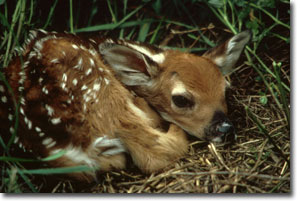
Spotted white-tailed deer fawns offer one of the most appealing sights in nature. Fawns typically appear walking closely to their protective mother or bounding across a field with seemingly unlimited energy. However, in May and June many fawns are found curled up in the field or forest alone, with no vigilant doe in sight. Is this an orphaned fawn? Almost certainly never!
White-tailed deer mate in the fall (October – December). The male deer (buck) plays no role in raising fawns. After the female deer (doe) gives birth to one or two fawns and nurses them, she leads them into secluded habitat within her familiar home range. Twin fawns can be separated by up to 200 feet. The doe then leaves them alone for extended periods of time. The doe returns periodically to nurse them and to relocate them to new secluded habitat. This pattern will continue for up to 3 weeks. By this time the fawns are mature enough to keep up with their mother and able to race out of real or perceived danger.
I’ve found a deer fawn (baby deer). What should I do?
Under most circumstances, the best thing a person can do is to immediately leave the area to avoid creating any additional disturbance near the fawn. On rare occasions, a fawn may approach people or pets. If this occurs, the fawn should be gently coaxed to lay down by pressing on its shoulders as the doe would do to keep the fawn still. The fawn should stay put, providing an opportunity for people and pets to leave the area.
The fawn was alone, with no mother protecting it. It is so small and helpless and it doesn’t even move when I approach it. Does it need help?
No, the fawn does not need your help. The doe (adult female deer) will rarely be found near her fawn for the first few weeks of its life because her presence may attract predators. The fawn is well camouflaged and has very little odor, which helps it hide from predators. Fawns instinctively lie motionless when approached by a potential predator. This seemingly helpless state is a behavioral adaptation that has helped white-tailed deer survive for ages. As fawns grow and mature, they will initially freeze, but they jump up and bound away. Once the fawn grows stronger, it will follow the doe while she forages.
It looks hungry, should I feed it?
People should never feed anything to a fawn. Fawns have very specific nutritional requirements and improper nutrition will make the fawn sick and may lead to its death.
My children touched the fawn and I’m afraid the mother won’t take it back - what should I do?
The doe-fawn bond is very strong. A mother deer will not avoid her fawn if there are human or pet odors on it. Fawns are rarely abandoned, except in extreme cases where the fawn has defects which will prevent its survival. The fawn should be placed in or next to natural vegetation near the location where it was found to provide cover and protection. The doe will avoid the area until the disturbance has passed, after which she will search for the missing fawn. If more than 24 hours have passed, the fawn may need attention from a wildlife rehabilitator.
Can I keep it?
No. Removing deer from the wild and keeping them in captivity is against the law in Maryland. Furthermore, the unnatural conditions of life in captivity can lead to malnutrition, injury, and stress at the hands of a well-meaning captor. Wild animals that become accustomed to humans can pose health risks and become dangerous as they mature.
The fawn is injured, what should I do? Who can I call?
Sometimes fawns are injured by pets, vehicles or farming equipment. Injured fawns should only receive care from a licensed Maryland wildlife rehabilitator who is authorized to handle fawns.
Fawn Rehabilitators will coordinate the transport and care of the fawn. You can get advice on what to do if you encounter an injured fawn, from a fawn rehabilitator. Click here for contact information for wildlife rehabilitators who may be able to assist with fawn rehabilitation.
Where Can I Find Out More Information?
For questions regarding fawns or other young wild animals, contact the Wildlife Services Information Line, toll free, at (877) 463-6497, or DNR’s Wildlife & Heritage Service at the following offices: Cumberland at (301) 777-2136; Bel Air at (410) 836-4559; Gaithersburg at (301) 258-7308; Annapolis at (410) 260-8540; or Wye Mills at (410) 827-8612, x105.
To report nuisance, injured or sick wildlife
(Monday - Friday, 8:00 am - 4:30 pm)
Call Toll-free in Maryland: 1-877-463-6497
For more information, please contact:
Maryland Department of Natural Resources
Wildlife and Heritage Service
Tawes State Office Building, E-1
Annapolis MD 21401
410-260-8540
Toll-free in Maryland: 1-877-620-8DNR, Ext. 8540
Acknowledgement:
Photo of White-tailed Deer Fawn, courtesy of W. J. Berg, USFWS